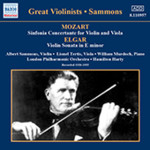
Mozart: Sinfonia Concertante / Elgar: Violin Sonata
 $25.00
Out of Stock
$25.00
Out of Stock6+ weeks add to cart
W. A. MOZART / EDWARD ELGAR
Mozart: Sinfonia Concertante / Elgar: Violin Sonata
Albert Sammons (violin) Lionel Tertis (viola) Gerald Moore (piano) / London Philharmonic Orchestra
[ Naxos Historical Great Violinists / CD ]
Release Date: Monday 5 May 2003
This item is currently out of stock. It may take 6 or more weeks to obtain from when you place your order as this is a specialist product.
The son and grandson of shoemakers, Albert Sammons was born in London on 23rd February 1886 and was taught the rudiments of violin playing by his father and elder brother. Later he had about thirty lessons from two Ysaÿe pupils, Alfredo Fernandez and Frederick Weist Hill, and John Saunders, a pupil of Bernhard Molique. Having first played professionally at the Earl's Court Exhibition in 1898, he left school at the age of twelve. From 1901 he was earning his living in theatre orchestras, switching for the summers to a hotel band in Harrogate, where in 1906 he performed Mendelssohn's E minor Concerto. In 1908 Beecham was recommended to hear him at the Waldorf Hotel in London, requested the finale of the Mendelssohn (which Sammons played 'at a speed which made me hold my breath') and offered him the second seat at the first desk in his new orchestra, soon promoting him to leader. In 1910 Sammons formed the New (later London) String Quartet, which he led for nine years, giving many first performances, including Delius's Quartet and Frank Bridge's Second Quartet. He also led the Philharmonic Society's orchestra, while making a name as a soloist - in 1910 he had a success with the Bruch Concerto in G minor at Queen's Hall under Stanford and then at the Royal Albert Hall under Landon Ronald. In 1911 he was appointed to the King's Band and in 1912 he played Saint-Saëns's Concerto in B minor before King George V and the composer. Although he detested foreign travel, a quirk which prevented his having an international career, he worked in both Germany (with the Russian Ballet) and France under Monteux. The first of many joint performances of the Elgar Concerto with the composer came in 1914, and he played chamber music privately with Ysaÿe, Thibaud and Rubinstein. Just before they both did war service in the Band of the Grenadier Guards (as clarinettists) Sammons linked up with the Australian pianist William Murdoch (1888-1942). Their duo was to be expanded into various chamber groups by the addition of Tertis and Felix Salmond (the cellist later replaced in turn by Cedric Sharpe, W.H. Squire and Lauri Kennedy). In 1919 Sammons edited and gave the first performance of the Delius Concerto, which he later recorded (Naxos 8.110951). Through the 1920s and early 1930s he was at the peak of his career. Despite the onset of Parkinson's disease, he gave many concerts up and down the United Kingdom during World War II, helping to keep up morale. He gave the première of Sir George Dyson's Concerto in 1942 and his last performance with orchestra, of E.J. Moeran's Concerto, was given in Norwich on 28th April 1946, with Sir Adrian Boult conducting - a recording of the concert survives. In March 1948 he retired from the concert platform. Sammons had a wide repertoire which took in the standard concertos as well as Bloch's and the first of Szymanowski's. He began his career on an instrument he had made himself. He then used a variety of violins, many of them new English instruments, but in 1927 bought the 1696 Matteo Gofriller which he plays on most of these recordings. His own compositions included a Phantasy Quartet (a Cobbett Prize-winner) as well as solos and studies for the violin. His later years were made difficult by illness but from 1939 to 1954 he taught at the Royal College, his best-known pupils being Alan Loveday and Hugh Bean. He died on 24th August, 1957.
"Made in 1935, towards the end of Sammons's glittering career, this first recording of the Elgar Violin Sonata connects us with the composer's own era and gives us a fascinating insight into the Edwardian interpretative style that was inherited by Sammons." Gramophone
"Albert Sammons was the greatest English violinist of his day, and he possessed a wonderful breadth of phrasing and sensitivity. His account of the E flat Sinfonia concertante, K. 364, remains one of the greatest performances of this masterpiece on record. It comes closer to Mozart than most subsequent recordings, particularly in the rapt, inward exchanges between the two soloists in the slow movement. Quite wonderful in fact. The fill-ups complete a splendid further tribute to Sammons's artistry." Penguin Guide
Tracks:
Mozart: Sinfonia concertante in E flat for Violin and Viola, K. 364
Nachez: Passacaglia on a Theme of Sammartini
Schubert; Rosamunde, D. 797: Entr'acte (arr. Brunet)
Dvorak: 8 Humoresques, Op. 101, B. 187: No. 7. Poco lento e grazioso in G-Flat Major (arr. Rehfeld)
Massenet: Thais, Act II: Meditation
Sammons: Bourree
Traditional: Londonderry Air (arr. A. Sammons)
Elgar: Violin Sonata in E Minor, Op. 82